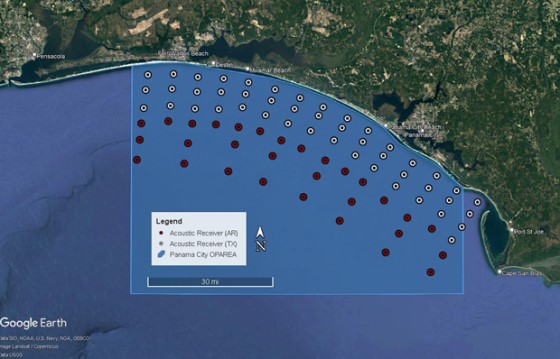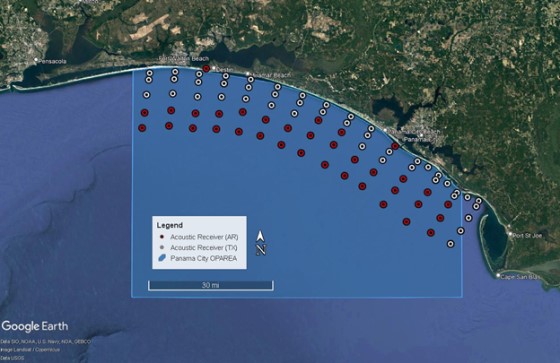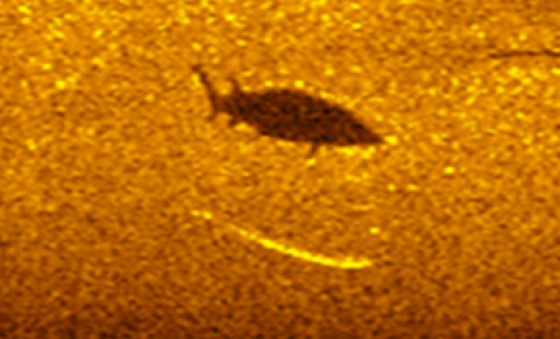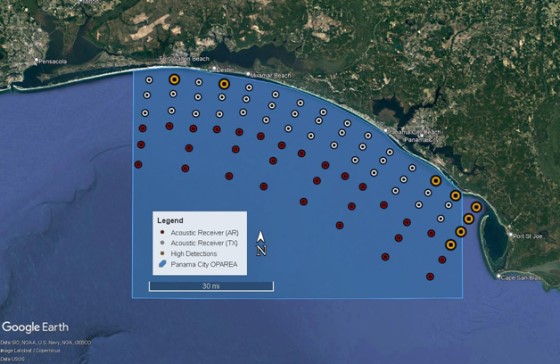Distribution of Gulf Sturgeon in the Panama City Testing Range
Introduction & Objectives
Widely considered the southernmost extant sturgeon species, prior to overharvest the anadromous Gulf Sturgeon (Acipenser oxyrinchus desotoi) occupied large river systems from Texas to peninsular Florida. Although their general patterns of habitat use and movement in estuarine and riverine systems is fairly well known, data to inform marine habitat use and occupancy modeling are generally lacking. Prior to population declines Gulf Sturgeon were found from the northern portions of South America throughout the northern Gulf of Mexico to the Florida Keys. Present freshwater distribution of Gulf Sturgeon appears limited to Gulf Coast river systems from the Mississippi River eastward to the Suwannee River, Florida. While current marine distribution patterns are less documented, they have likely contracted with the concurrent loss of rivers at the edges of their distribution. Ultimately concerns centered on habitat loss/alternation and overharvest led to the ESA listing of Gulf Sturgeon as threatened in 1991.
Unlike the closely related Atlantic sturgeon (Acipenser oxyrinchus oxyrinchus)both juvenile and adult Gulf Sturgeon participate in the riverine migrations. Following emigration from the rivers into estuaries in the fall most adult Gulf Sturgeon are believed to move into marine waters to where they spend the winter months foraging to offset prolonged periods of fasting during freshwater residence. The limited information that exists, suggests adult Gulf Sturgeon occupy nearshore marine during winter months thereby underscoring the importance of this region for growth and gonadal recrudescence. The lack of information on their habitat use and movement in marine waters is especially troubling when one considers that adults spend a major portion of their life in non-riverine habitats.
The paucity of data on marine habitat use by Gulf Sturgeon was highlighted in the aftermath of the 2010 Deepwater Horizon Oil Spill. In response to the spill event a range-wide study to examine the impact on Gulf Sturgeon was implemented. While the broad scale telemetry findings have yet to be published, the Natural Resource Damage Assessment Trustees estimated that large numbers of adult and sub-adult Gulf Sturgeon were potentially exposed to oil. In the northern Gulf of Mexico, limited efforts have been undertaken to examine marine distribution and the preliminary finding from studies done in conjunction between the U.S. Fish and Wildlife Service and Eglin Air Force Base contractors suggest that, upon exiting from north central Gulf rivers in the fall, Gulf Sturgeon are thought to move west to Perdido Key, FL and east off of Panama City, FL. Their findings bolster the work of others which have documented concentrations of sturgeon between the entrances of Saint Andrews and Saint Joseph Bays which corresponds to the eastern portion of the Panama City Operating Area (OPAREA).
During freshwater residency which extends from the spring to the fall, adult Gulf sturgeon undergo a prolonged period of fasting before transiting to marine foraging areas. The lack of freshwater foraging focuses the role of marine habitats in subsequent reproductive success and ultimately is a key to the recovery of this species. Improving the limited understanding of marine habitat requirements is emphasized in the Gulf Sturgeon Recovery Plan, which highlights the need for multi-year tracking studies and will also assist in the Biological Assessment required under Section 7 of the ESA. Our project, which leverages large numbers of pre-existing transmitters and passive acoustic receivers, will provide much needed information to the Naval Sea Systems Command (NAVSEA) on the spatial temporal patterns of occupancy for the ESA listed Gulf Sturgeon in the Naval Surface Warfare Center (NSWC), Panama City Division Testing Range and the Panama City OPAREA. This information can then be used to provide a framework for subsequent efforts to examine the exposure and response to Navy activities as well as the consequences of these responses.
Technical Approach
Tagging- Using large mesh drift monofilament we captured 31 adult Gulf Sturgeon in the lower portions of the Choctawhatchee River in early October, 2021. Our decision to target individuals from the Choctawhatchee River is based on previous findings suggesting that individuals from this river system are likely to occupy areas in the NSWC Panama City Division Testing Range during the winter months. Gulf Sturgeon were measured and weighed and a small tissue sample from the caudal fin was fixed in 95% ethanol and provided to Dr. B. Kreiser (University of Southern Mississippi) for genetic analysis. All Gulf Sturgeon received, a 12mm 134.2 kHz PIT tag implanted at the left base of the dorsal fin; 30 Gulf Sturgeon received a long lived (≈10-year battery life) acoustic transmitter (Innovasea- VEMCO V-16-6H) implanted into the celomic cavity. These 30 transmitters will help supplement approximately 400 acoustically tagged Gulf Sturgeon of all life stages that have been deployed by federal, state, and academic partners across the species’ range. Previous efforts in the Choctawhatchee River have deployed 105 long-lived transmitters (D. Fox and S. Rider unpublished) into adult Gulf Sturgeon in the past three years for projects focused on in-river habitats that are available for use in this project. Additionally, there are several ongoing projects focused on adult Gulf Sturgeon that will continue to deploy transmitters that will be available for detection in the Gulf of Mexico. Our tagging efforts help provide robust numbers of transmitters at large to increase the probability of detection in marine environments.
Passive Acoustic Telemetry- Leveraging telemetered Gulf Sturgeon, we deployed an array of passive acoustic receivers encompassing approximately 145 km of linear shoreline and up to 40 km offshore (Figure 1) from October to May, the time of year when Gulf Sturgeon occupy the marine environment. The array is comprised of approximately 76 passive acoustic receivers which is a mix of Innovasea-VEMCO VR2TX (46), and Innovasea-VEMCO VR2AR (acoustic release) receivers (30) (https://support.fishtracking.innovasea.com). Both receiver models are capable of two-way communication with the base tracking unit (VEMCO V100) outfitted with a transceiving hydrophone (VEMCO VHTX). The VEMCO VR2TX receivers were deployed along the shallower regions of the array while we will reserved the acoustic release receivers (VR2AR) for locations where the use of ground lines and or grappling was prohibitive (e.g., reefs or cables). All receivers had no surface expression, thereby minimizing the risk of entanglement by vessels or marine mammals, as well as decreasing vandalism and loss by members of the public. The goal for the first year of the array was to cover a wide area to ensure detection of Gulf Sturgeon in all possible habitats utilized. This base year will provide estimates that will be utilized to redefine the array configuration in subsequent years to maximize detection probabilities. Receivers were arranged in a linear fashion with four receivers placed at 5, 10, 15, and 20 km offshore. Additional receivers placed at 30 and 40km from shore on every other line to capture any movements if they occurred in this habitat.
Utilizing initial finds from year one, the array configuration was modified for year 2. Specifically, the receivers deployed in year one at 30 and 40km that did not detect any Gulf Sturgeon were deployed between the northern most receivers and the shoreline (Figure 2). An additional, three receivers were deployed between the lines of receivers in the nearshore environment to the east of St. Andrew’s Inlet as this was where the highest concentration of Gulf Sturgeon was detected. One additional receiver was also placed inside of Destin Pass to better characterize movement from the estuarine to the marine environment by adult Gulf Sturgeon. The array configuration for year 3 will again be tailored based on findings in year 2 with the deployment timeframe occurring from October to May.
The location of our project will complement ongoing efforts by other regional scientists as the planned study area is devoid of telemetry infrastructure.

Figure 1. Overview of NAVSEA Gulf of Mexico testing area and NSWC Panama City Division Testing Range Operations Area with the year one passive acoustic receiver array (VEMCO VR2TX and VR2AR).

Figure 2. Overview of NAVSEA Gulf of Mexico testing area and NSWC Panama City Division Testing Range Operations Area with the year two passive acoustic receiver array (VEMCO VR2TX and VR2AR).
Unmanned Underwater Vehicle- We will supplement the acoustic receiver array with mobile tracking and sonar imaging using a REMUS 100 Unmanned Underwater Vehicle outfitted with a Innovasea-VEMCO receiving hydrophone to detect transmitters that may not be within the detection range of receivers, as well as high resolution (600-1200khz) sidescan sonar to detect sturgeon within sonar range. The REMUS 100 is a prop driven autonomous platform that navigates using ultra short baseline and long baseline acoustic navigation via a compass, and an acoustic Doppler current profiler (ADCP) to calculate its position in real-time underwater with meter-scale accuracy. Data are stored internally and downloaded at the mission’s end for review by the operators to inform mission planning/sampling for the next day. Daily mission duration will be from 6-8 hours covering > 50 linear km or 2 km2 of seafloor.

Figure 3. Acoustic image of a large sturgeon (>1.5m) and its acoustic shadow taken from side scan sonar during a previous project.
Leveraging Gulf Sturgeon detection patterns from year one, dynamic UUV mission planning in years two and three will be utilized to survey Panama City OPAREA and optimize detection of tagged fishes that otherwise may be missed by the resolution of the acoustic array. We will deploy UUVs for 6-8-hour continuous missions focusing on portions of the study area where Gulf Sturgeon are likely to congregate based on acoustic telemetry. The use of this mobile receiver platform and sonar imaging may lead to the discovery of new aggregations by detecting congregations of Gulf Sturgeon. If the presence of sturgeon is indicated after daily review of the side scan sonar and telemetry data from the UUV targeted active tracking and modified missions will occur in those areas to realize the extent of an aggregation and determine habitat preferences.
Analytical Approach- Our project will directly support the NAVSEA monitoring program by developing spatial temporal distribution models of Gulf Sturgeon as well as other telemetered species including ESA listed sea turtles, manatees, and smalltooth sawfish in the Panama City OPAREA and the NSWC Panama City Testing Range. Specifically, we will focus on describing the occurrence of protected species in this region which will provide a framework for subsequent efforts to examine the exposure and response to Navy activities, as well as the consequences of these responses. Our project will focus on the least understood segment of the Gulf Sturgeon lifecycle, yet one that is ultimately crucial to its conservation and recovery: marine habitat. Our project will provide a wide coverage area in year one that will be tailored in the final two years of this project to highlight core habitat areas for Gulf Sturgeon within the Panama City OPAREA. Each year, seasonal use maps will be created showing the overlap of the OPAREA with Gulf Sturgeon occupancy by month or even week depending on use dynamics. Fine-scale habitat features such as water depth, and substrate as well as oceanographic in-situ and remote sensed parameters will be linked to Gulf Sturgeon occurrence to identify similar areas within the OPAREA where Gulf Sturgeon are likely to occur. Predictive models using advanced modelling techniques such as Generalized Additive Mixed Models and/or Boosted Regression Trees will be explored to maximize the predictive power and increase the resolution of the occurrence estimates. Once developed these models can be used to estimate Gulf Sturgeon occurrence based on oceanographic conditions. The use of seasonal occurrence estimates can alert the NAVSEA if potentially hazardous activities may co-occur and cause harm to Gulf Sturgeon before they take place. Additionally, the use of climatological data with these models can allow for seasonal use planning to avoid negative impacts.
Progress & Results
In 2021, the Gulf sturgeon habitat study commenced with the capture and tagging of 31 Gulf sturgeon in the lower Choctawhatchee River. These sturgeon were fitted with acoustic transmitters, and an array of 79 receivers was deployed in the Gulf of Mexico, covering approximately 145 km of coastline and extending 40 km offshore. Initial data revealed that tagged sturgeon remained predominantly in nearshore waters, a trend that would continue throughout the study. In addition to sturgeon, the array detected numerous other species, highlighting the area's diverse marine life. Fourteen AUV missions were conducted in 2022 and 2023 to visually locate sturgeon and test detection ranges of receivers.
In 2022, the receiver array was reconfigured to focus on a finer-scale area within the NSWC Panama City Test Range, aiming to identify important habitats and seasonal patterns within the sturgeon's winter foraging grounds. This reconfiguration maximized detection opportunities within the nearshore environment. One receiver was temporarily lost but later recovered. The study continued to confirm the importance of nearshore habitats for Gulf sturgeon, with detections concentrated within 5km of the shore, corresponding with designated critical habitat. An additional 25 sturgeon were tagged in October 2023, increasing the sample size for the ongoing study.
In 2023 and 2024, the refined acoustic array remained deployed, including an over-summer deployment to investigate species presence outside the typical Gulf sturgeon winter range. The array was serviced regularly. A final AUV mission in February 2024 faced challenges due to rough sea conditions and had to be relocated to deeper waters, limiting its effectiveness in observing nearshore sturgeon. Data analysis is ongoing, integrating telemetry data with environmental factors. The project is expected to conclude in spring/summer 2025 with a comprehensive analysis of sturgeon habitat use and movement patterns, contributing significantly to conservation efforts.

Figure 4. Panama City OPAREA and acoustic receiver array highlighting the areas of high Gulf Sturgeon Detection.
Project Information
Location: NSWC Panama City Testing Range
Timeline: 2021–2025
Funding: FY21 - $177K, FY22 - $149K, FY23 - $152K
Points of Contact
Principle Investigators
Dewayne A. Fox
Delaware State University
Matthew W. Breece
University of Delaware
Project Manager
Shelby Creager
Naval Sea Systems Command

